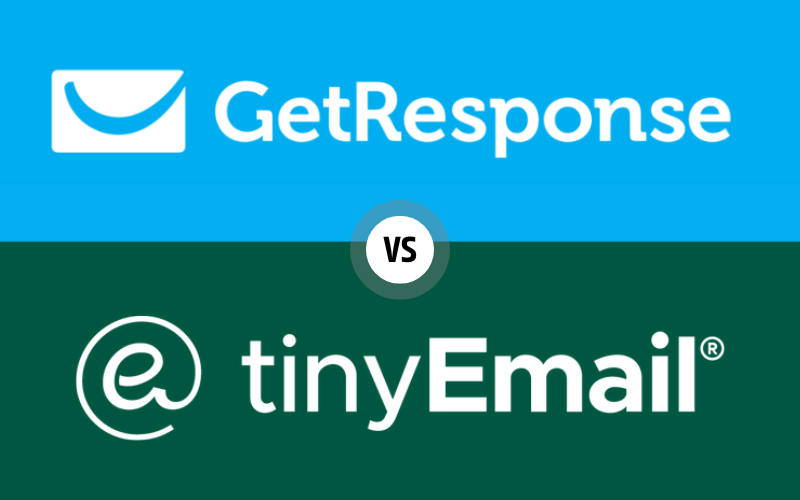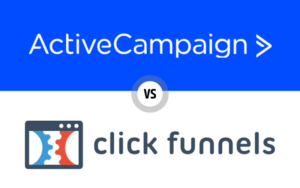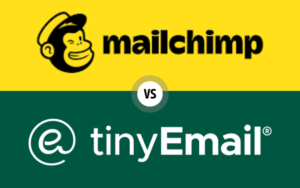In the comparison between GetResponse vs TinyEmail within the vast sea of email marketing tools, both names have emerged as prominent contenders, sparking significant discussions among marketers, businesses, and digital enthusiasts.
GetResponse: With over two decades in the industry, GetResponse has cemented its standing as a reliable and comprehensive email marketing platform. Transitioning from a basic email tool to an all-encompassing marketing suite, it has continuously adapted to diverse business needs, refining its features in line with the dynamic digital environment.
TinyEmail: As a newer addition to the market, TinyEmail has swiftly risen in prominence. Despite its relatively shorter history, it has demonstrated significant innovation by offering modern, intuitive, and forward-thinking solutions. Prioritizing the needs of today’s agile businesses, flexibility and adaptability lie at the heart of TinyEmail’s offerings.
As we journey through this post, we’ll delve deep into the specifics, strengths, and potential areas of growth for both platforms, equipping you with a comprehensive guide to make informed decisions.
Table of Contents
User Experience and Interface
Navigating through an email marketing platform can be a determining factor for many users. Ease of use, design intuitiveness, and interface responsiveness play crucial roles in determining how efficiently users can execute their campaigns. In the battle of GetResponse vs TinyEmail, both platforms bring their unique flair to the table.
GetResponse
GetResponse offers a sleek and user-friendly interface that even novices find easy to navigate. Its drag-and-drop editor, streamlined dashboard, and logically placed tools make campaign creation a breeze. With tool tips, tutorial pop-ups, and a clean layout, GetResponse ensures that users spend less time figuring things out and more time on their email marketing strategies.

TinyEmail
TinyEmail, in contrast, adopts a minimalist approach. Its clutter-free interface focuses on function over form, ensuring that users find what they need without unnecessary distractions. With a focus on user-centric design, TinyEmail presents a straightforward navigation system, making it simple for users to jump from one feature to another. It also provides a robust search functionality, which helps users quickly find tools or settings they’re looking for.

Comparison
When contrasting GetResponse vs TinyEmail in terms of user experience and interface, both cater to different audiences. While GetResponse offers more visual cues and an aesthetically pleasing interface, TinyEmail prioritizes efficiency and function. The choice between the two would boil down to personal preference: whether a user values design aesthetics or a no-nonsense functional approach.
To wrap up this section, both GetResponse and TinyEmail have put significant thought into their platforms’ user experiences. While the two differ in design philosophies, both aim to ensure that users can implement their email marketing campaigns with ease and efficiency.
Pricing and Plans
When deciding between GetResponse and TinyEmail, understanding the pricing structure and the value it offers is crucial. Let’s break down the pricing and plans of both to see which offers the best bang for your buck.
GetResponse
GetResponse’s commitment to offering varied solutions for different business needs is evident in their tiered pricing plans. Starting with a 30-day free trial, it gives newcomers an opportunity to gauge the platform’s fit for their needs. Their plans are structured based on the number of subscribers. From basic email marketing solutions to advanced e-commerce features, each tier is meticulously designed to cater to specific business requirements. For those who are in for the long haul, GetResponse offers annual and biennial plans with substantial discounts, reflecting their emphasis on forging long-term relationships.
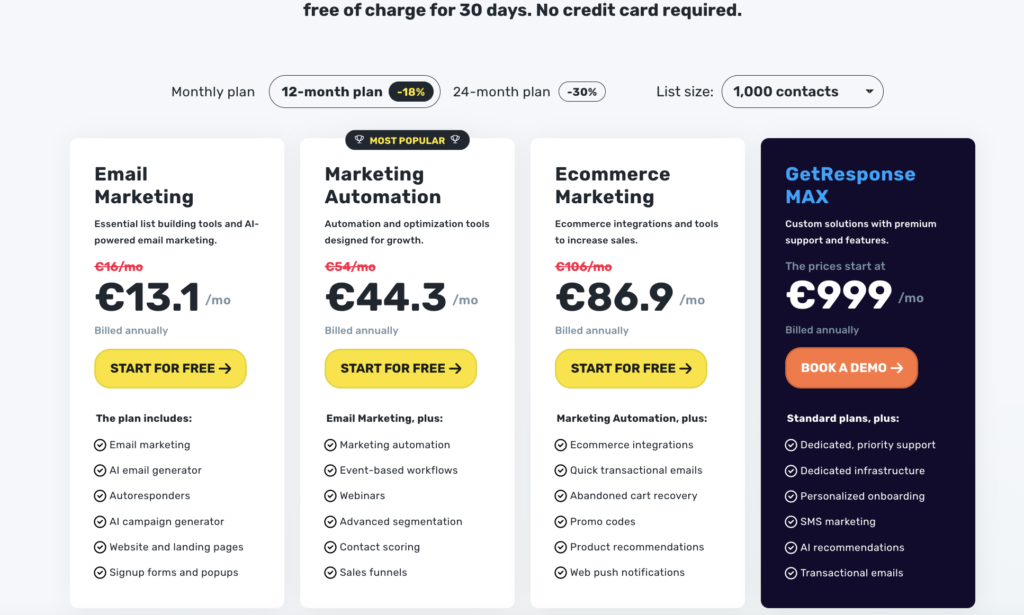
TinyEmail
TinyEmail’s approach to pricing might be slightly different. With an affordable starting price, they capture the attention of startups and small businesses. Instead of segregating features, they may opt for an all-inclusive plan, charging merely based on the number of subscribers. This straightforwardness can be a boon for those who dislike navigating through complex pricing structures. For large enterprises with specific requirements, TinyEmail stands ready with custom pricing solutions, underscoring their flexibility.

Comparison
Pricing structures of TinyEmail vs GetResponse highlight the contrasting approaches these platforms take. While GetResponse offers a graded experience, allowing businesses to grow and transition between tiers, TinyEmail’s straightforward approach is geared towards those who prefer simplicity and clarity. The key is to understand your brand’s specific requirements, growth trajectory, and budgetary constraints to make an informed decision.
To sum up, while cost is a significant factor in decision-making, it’s paramount to assess the value each platform offers. GetResponse and TinyEmail, with their distinct pricing models, cater to a broad spectrum of business needs. Your final choice should align not just with your current requirements, but also with your future aspirations and growth plans.
Email Design and Templates
Having a variety of design options and templates can make the email creation process smoother and more efficient. The visual appeal of your emails plays a crucial role in engagement rates. Let’s examine how GetResponse and TinyEmail compare in this domain.
GetResponse
GetResponse offers an extensive library of beautifully designed email templates. Whether you’re promoting a sale, sending out a newsletter, or simply engaging with your audience, there’s a template suited for every occasion. These templates are mobile-responsive, ensuring they look great on all devices. Additionally, their drag-and-drop editor allows for easy customization, letting brands infuse their unique identity into every email.

TinyEmail
TinyEmail prioritizes flexibility in design. While they offer a curated selection of templates, their primary strength lies in their intuitive design builder. This tool lets users craft emails from scratch or tweak existing templates to perfection. For brands with a specific vision or those who want to maintain strict brand guidelines, TinyEmail’s design capabilities are a boon. Their designs, like GetResponse’s, are mobile-optimized, ensuring a consistent viewing experience across devices.

Comparison
In the contest of GetResponse vs TinyEmail for email design and templates, both platforms bring strong offerings to the table. GetResponse excels with its vast template library, while TinyEmail shines with its flexible design builder. Your choice might pivot on whether you prefer starting with a template and customizing or crafting unique designs from the ground up.
Both platforms recognize the importance of visually appealing, mobile-responsive emails in today’s digital age. Your selection between GetResponse and TinyEmail would ultimately depend on your design preferences, the amount of customization you desire, and the resources you have at hand for email creation.
Email Automation Capabilities
Automation is a game-changer in email marketing. With the right tools, businesses can set up campaigns that run on autopilot, ensuring timely and relevant communication with their audience. Let’s dive into the automation features of GetResponse and TinyEmail.
GetResponse
GetResponse’s email automation capabilities are robust and user-friendly. Users can craft automation workflows using their drag-and-drop builder, making the setup process straightforward. The platform supports a variety of triggers, from subscriber actions (like opening an email or clicking on a link) to specific dates or events. This versatility allows for highly personalized email campaigns that cater to the individual journey of each subscriber.

TinyEmail
TinyEmail offers a more streamlined approach to email automation. While it might not have the breadth of triggers that GetResponse boasts, it offers depth in its targeting and segmentation capabilities. Their automation workflows are designed to be simple yet effective, allowing businesses to set up campaigns that resonate with specific audience segments. Additionally, TinyEmail provides analytics tools that help users optimize their automated campaigns over time.

Comparison
When weighing GetResponse vs TinyEmail in terms of email automation, it’s evident that both platforms have distinct strengths. GetResponse provides a broader range of automation triggers and a highly visual builder, ideal for those who want granular control over their campaigns. On the other hand, TinyEmail’s focus on segmentation and optimization makes it a strong contender for businesses looking to continuously refine their strategies.
In conclusion, the choice between GetResponse and TinyEmail for automation would depend on your brand’s specific needs. If you want a vast array of automation triggers and a visual interface, GetResponse might be more up your alley. However, if your focus is on segmenting your audience and optimizing campaigns based on real-time data, TinyEmail could be the better fit.
Segmentation and Personalization
In the realm of email marketing, segmentation and personalization are pivotal for crafting targeted campaigns and driving user engagement. How do GetResponse and TinyEmail measure up in these crucial areas? Let’s explore.
GetResponse
GetResponse boasts sophisticated segmentation capabilities, allowing businesses to divide their contact lists based on various criteria, such as location, past purchase behavior, and engagement metrics. By understanding and leveraging these subdivisions, brands can craft highly personalized emails, ensuring relevance to the recipient. Further enhancing its personalization capabilities, GetResponse offers dynamic content adjustment, enabling brands to show different content to different segments, all within a single email campaign.
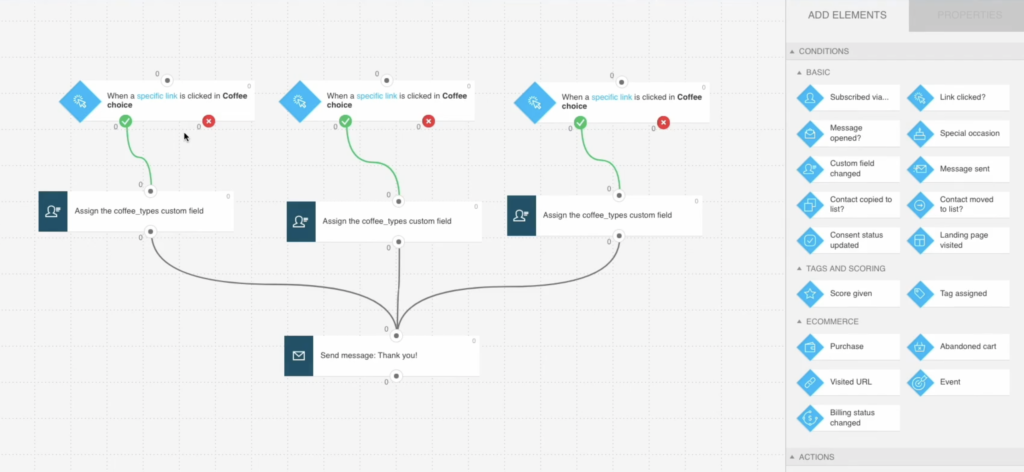
TinyEmail
TinyEmail, though newer, has put a strong emphasis on providing advanced segmentation and personalization features. Users can effortlessly segment contacts based on diverse metrics, from basic demographic details to intricate behavioral patterns. TinyEmail’s personalization tools empower brands to craft bespoke email experiences for every subscriber, fostering deeper connections and improved campaign efficacy. Their intuitive drag-and-drop editor complements this, making the creation of tailored email designs a breeze.
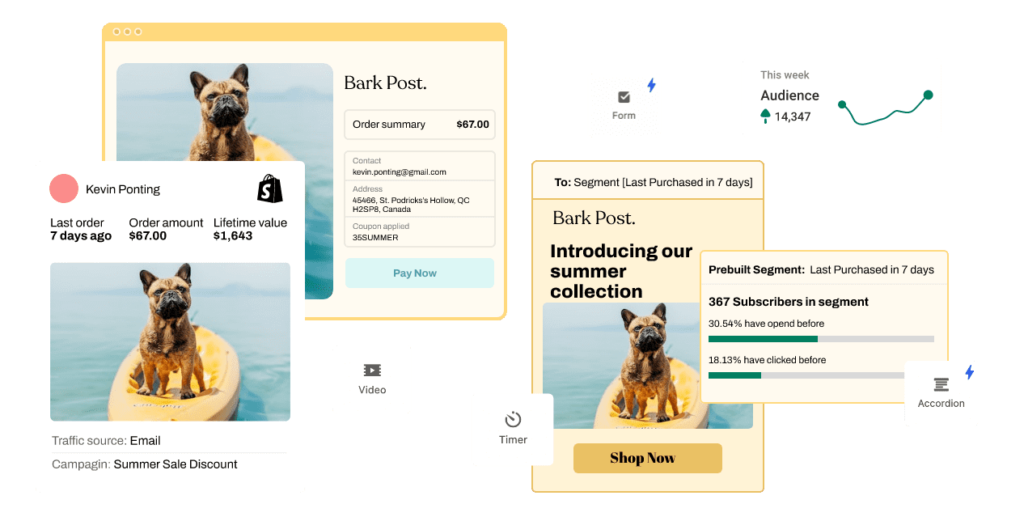
Comparison
Both TinyEmail vs GetResponse prioritize segmentation and personalization, recognizing their immense value in today’s email marketing landscape. While GetResponse offers in-depth segmentation with dynamic content adjustment, TinyEmail impresses with its intuitive tools and flexible personalization features.
In sum, for brands aiming to provide tailored email experiences that resonate with their audience, both GetResponse and TinyEmail are worthy contenders, with distinct features catering to varying needs.
Integration Capabilities
In the current digital ecosystem, an email marketing platform’s ability to seamlessly integrate with other tools and systems can be a significant factor in its overall effectiveness. Let’s delve into the integration capabilities of both GetResponse and TinyEmail.
GetResponse
GetResponse offers an expansive library of integrations, catering to various business needs. Whether you’re looking to connect your e-commerce platform, CRM system, or even your social media accounts, GetResponse has likely got you covered. Their API is robust and developer-friendly, ensuring that businesses can even craft custom integrations when needed.
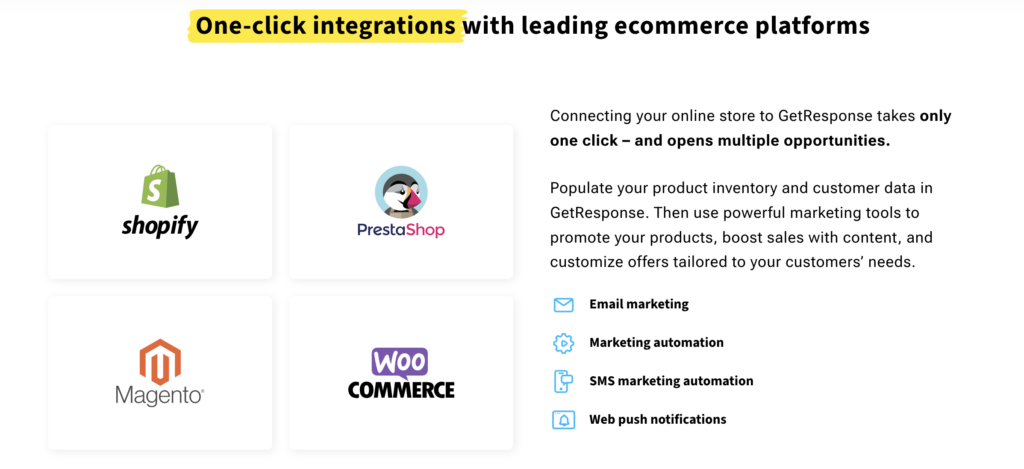
TinyEmail
TinyEmail, despite being a newer player in the market, has made significant strides in integration capabilities. They provide native integrations with several essential platforms, from e-commerce to webinar tools. Their API documentation is detailed, empowering developers to integrate TinyEmail into diverse digital ecosystems seamlessly.

Comparison
When comparing GetResponse vs TinyEmail in terms of integration capabilities, there are differences to note. GetResponse, with its longer presence in the market, boasts a more extensive integration library. However, TinyEmail’s focus on modern tools and its commitment to a user-friendly API suggests it’s keen on leveling the playing field quickly.
Ultimately, your choice between the two may hinge on specific tools you currently use or plan to incorporate into your marketing stack. Both platforms offer strong integration support, but the specifics of your digital environment might favor one over the other.
Deliverability Rates
A pivotal aspect of any email marketing tool’s efficacy is its deliverability rate. Simply put, if your emails aren’t reaching your subscribers’ inboxes, then even the most beautifully crafted campaigns can fall flat. As we assess GetResponse vs TinyEmail, let’s consider how each ensures your emails find their intended recipients.
GetResponse
With its established reputation, GetResponse has continually invested in optimizing deliverability rates. Their advanced algorithms detect potential delivery issues in real-time, allowing for adjustments on-the-fly. Partnering with ISPs and maintaining white-list agreements, GetResponse ensures that your emails largely bypass the dreaded spam folder.
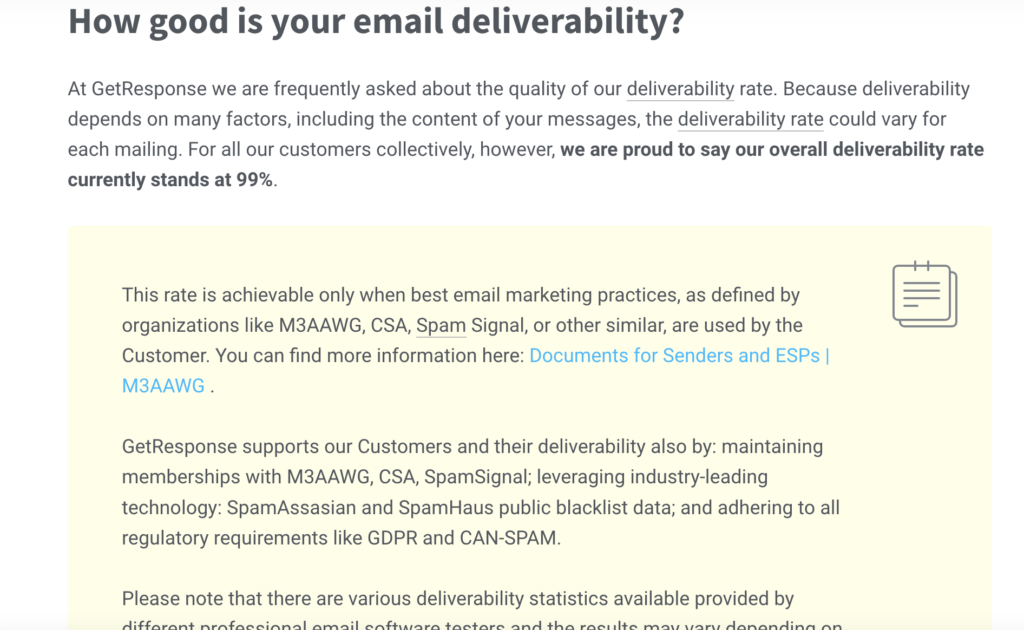
TinyEmail
TinyEmail, understanding the critical nature of email deliverability, has prioritized this from its inception. They utilize adaptive algorithms to continually learn and adjust to ever-evolving email landscape challenges. By proactively managing sender reputations and emphasizing user education on best practices, TinyEmail endeavors to maintain commendable deliverability rates.
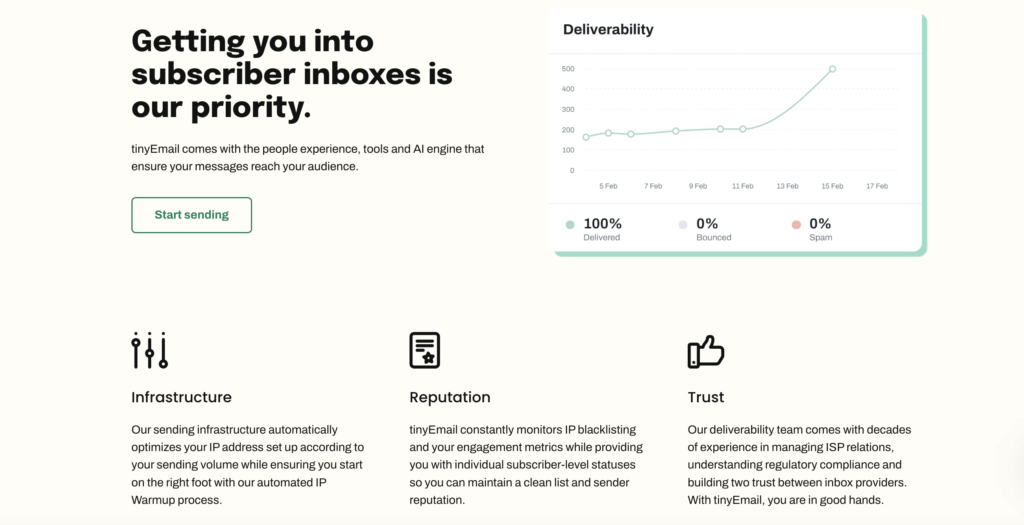
Comparison
In the faceoff of GetResponse vs TinyEmail regarding deliverability, both platforms show a profound commitment to ensuring emails reach their mark. While GetResponse leverages its long-standing relationships and industry experience, TinyEmail’s innovative and adaptive approach is noteworthy. It’s crucial to monitor deliverability metrics with any platform, as this is a dynamic metric that can be influenced by various factors beyond the platform itself.
For businesses, this translates to understanding that while platform selection is essential, adhering to email marketing best practices is equally crucial to maintaining high deliverability rates.
Reporting and Analytics
Understanding campaign performance and subscriber behavior is foundational to refining email marketing strategies. The depth, clarity, and actionable insights provided by reporting and analytics tools can significantly influence an email marketer’s decision when comparing GetResponse vs TinyEmail.
GetResponse
GetResponse provides a comprehensive suite of analytics tools. Users can track open rates, click-through rates, geolocation of readers, and even the devices on which emails were accessed. Their visual reports simplify data interpretation, making it easier to adjust campaigns on-the-go. Plus, GetResponse offers A/B testing capabilities, allowing marketers to fine-tune their strategies by directly comparing variant performances.
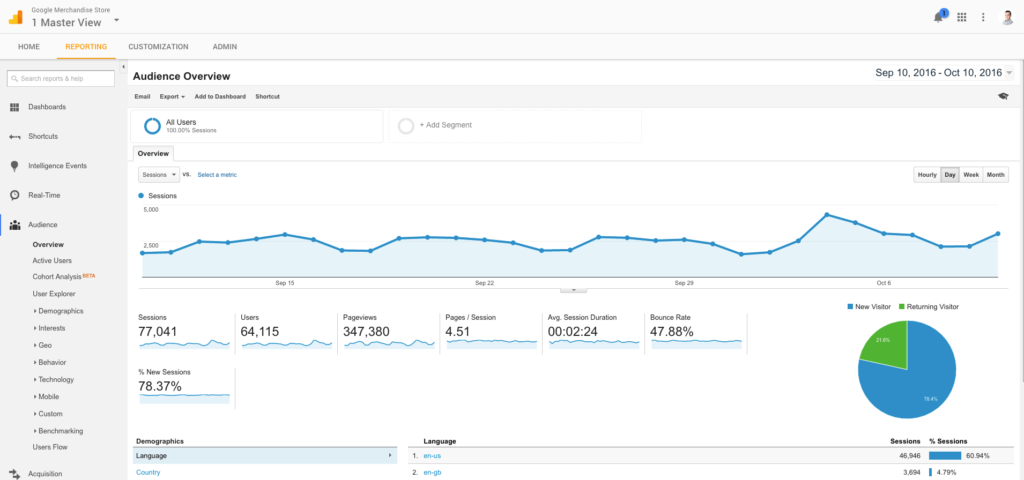
TinyEmail
TinyEmail emphasizes data-driven decision-making. Their analytics dashboard offers real-time data updates, ensuring that marketers can pivot their strategies in timely manners. From tracking unsubscribes to monitoring engagement over different time zones, TinyEmail provides a granular look into subscriber behavior. Furthermore, their heatmap analytics offer a visual representation of where subscribers are most engaged in emails, providing insights on layout and content placement.

Comparison
When we weigh GetResponse vs TinyEmail in terms of reporting and analytics, both platforms stand out for their distinctive offerings. While GetResponse offers a traditional yet comprehensive set of analytics tools, TinyEmail introduces innovative features like heatmap analytics. The choice between them would depend on the specific analytical needs of the marketer and their preference for data presentation.
In the evolving world of email marketing, having a pulse on campaign performances through dynamic and insightful analytics can significantly enhance outreach effectiveness and ROI.
Customer Support and Resources
Quality customer support can be a game-changer, especially in an industry where rapid changes and technical challenges are par for the course. When comparing GetResponse vs TinyEmail, the efficiency, accessibility, and depth of customer support, as well as the breadth of educational resources, become paramount.
GetResponse
GetResponse prides itself on its 24/7 customer support. Whether it’s through live chat, email, or phone, they are always available to assist their users. Additionally, GetResponse offers a rich knowledge base filled with tutorials, webinars, and guides. For those who prefer community-driven solutions, their active user forums are a treasure trove of shared experiences and solutions.
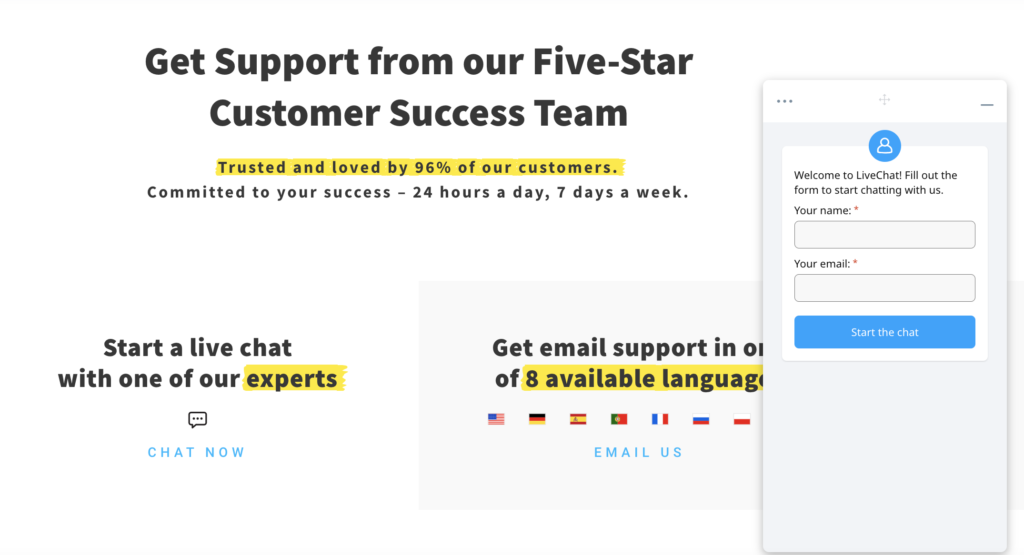
TinyEmail
TinyEmail understands the importance of timely support. They offer round-the-clock live chat support, ensuring that users get immediate assistance when they need it most. Moreover, TinyEmail’s academy provides video lessons, detailed articles, and periodic webinars that empower users to maximize the platform’s potential. Their FAQ section is continually updated, reflecting the evolving needs and questions of their user community.

Comparison
Weighing GetResponse vs TinyEmail based on customer support and resources reveals that both platforms are deeply committed to their user community. While GetResponse offers a multi-modal approach to support coupled with an extensive knowledge base, TinyEmail emphasizes real-time chat support and has invested significantly in its educational academy. The deciding factor might be personal preference: do users want more traditional support methods or immediate live chat responses?
In the realm of email marketing tools, having robust support and a wealth of learning resources can significantly smoothen the learning curve and ensure uninterrupted campaign execution.
Security and Compliance
In today’s digital age, the security of user data and adherence to regulatory compliance standards are fundamental considerations for any software solution. When evaluating TinyEmail vs GetResponse, it’s paramount to discern how each platform ensures the protection of user data and aligns with industry regulations.
GetResponse
GetResponse showcases a multi-layered security approach, ensuring data safety at all times. The platform operates with secure HTTPS protocol, meaning data in transit is encrypted. With state-of-the-art data centers and real-time monitoring, GetResponse affirms its commitment to data integrity. On the compliance front, the platform adheres to GDPR and other international regulations, ensuring users’ data privacy rights are protected.

TinyEmail
TinyEmail, too, emphasizes the importance of robust security measures. Their advanced encryption techniques safeguard both data at rest and in transit. Conducting regular vulnerability assessments and penetration tests, TinyEmail assures their systems remain resilient against threats. In terms of compliance, TinyEmail aligns with GDPR and numerous other international data protection standards, further establishing trust among its user base.

Comparison
Drawing a parallel between GetResponse vs TinyEmail in terms of security and compliance, it’s evident that both prioritize user data protection. While GetResponse boasts a robust security infrastructure, TinyEmail’s systematic approach to regular security assessments and extensive compliance alignment makes it a strong contender. Selecting between the two might come down to specific security features or compliance credentials more pertinent to individual needs.
In the realm of email marketing platforms, both GetResponse and TinyEmail understand the significance of maintaining security and upholding compliance, assuring users that their data is treated with utmost respect and caution.
Feedback and Reviews
To make an informed decision between GetResponse vs TinyEmail, examining user feedback and reviews is pivotal. They provide a transparent view into real-world usage and experiences, cutting through marketing hype.
GetResponse
Widely acknowledged in various email marketing discussions and online forums, GetResponse has garnered a mix of opinions. While many users appreciate its intuitive interface and comprehensive email marketing features, some users have pointed out occasional software glitches and steep learning curves. Notably, review sites such as Capterra and G2 Crowd have several user testimonials that can provide insights into specific strengths and areas for improvement.
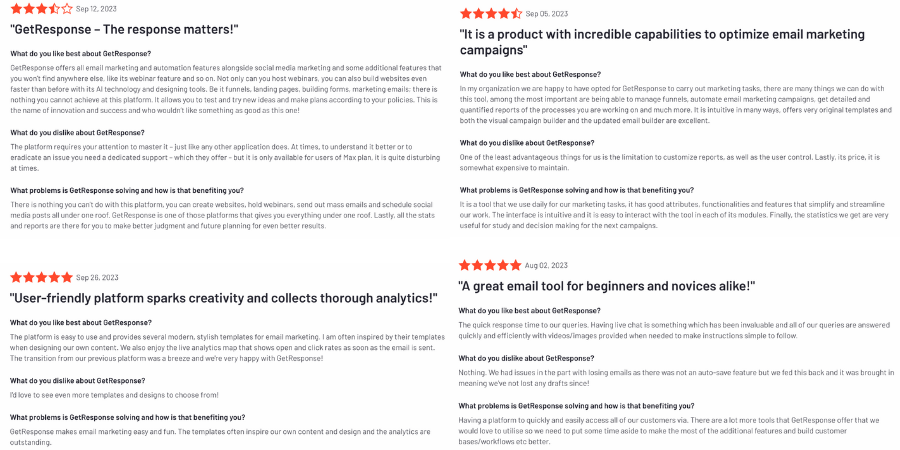
TinyEmail
TinyEmail, though relatively newer in the email marketing landscape, has started making waves. User feedback highlights its ease of use, exceptional customer support, and seamless integrations. However, as with any platform, some users feel there are areas ripe for enhancement, particularly around advanced analytics. Exploring review platforms and community forums can offer deeper insights into what current users truly think about TinyEmail.

Comparison
When analyzing feedback and reviews for GetResponse vs TinyEmail, it’s crucial to note the evolving nature of software tools. Both platforms have their admirers and critics. While GetResponse, being longer in the industry, has a vast array of reviews, TinyEmail’s growing reputation is hard to overlook. Potential users should weigh these reviews in light of their specific needs, considering factors like ease of use, feature requirements, and budget.
Remember, reviews are subjective. It’s essential to test both platforms and see which one aligns best with your email marketing goals.
Scalability
When considering the long-term viability of an email marketing platform, scalability is an essential factor. It determines how well a platform can grow alongside your business and adapt to increasing demands.
GetResponse
Over the years, GetResponse has shown a commitment to cater to businesses of all sizes. From solopreneurs to large enterprises, its platform offers a variety of plans tailored to different needs. With features that can accommodate an expanding email list, sophisticated segmentation, and an array of automation capabilities, GetResponse ensures that as your business scales up, your email marketing efforts won’t be left behind.

TinyEmail
TinyEmail, while newer to the scene, has been designed with scalability in mind. Its modular architecture means that users can add functionalities as they grow. With its flexible pricing model and ability to handle vast email lists seamlessly, TinyEmail is poised to support businesses throughout their growth journey, ensuring that email marketing remains efficient, regardless of size.
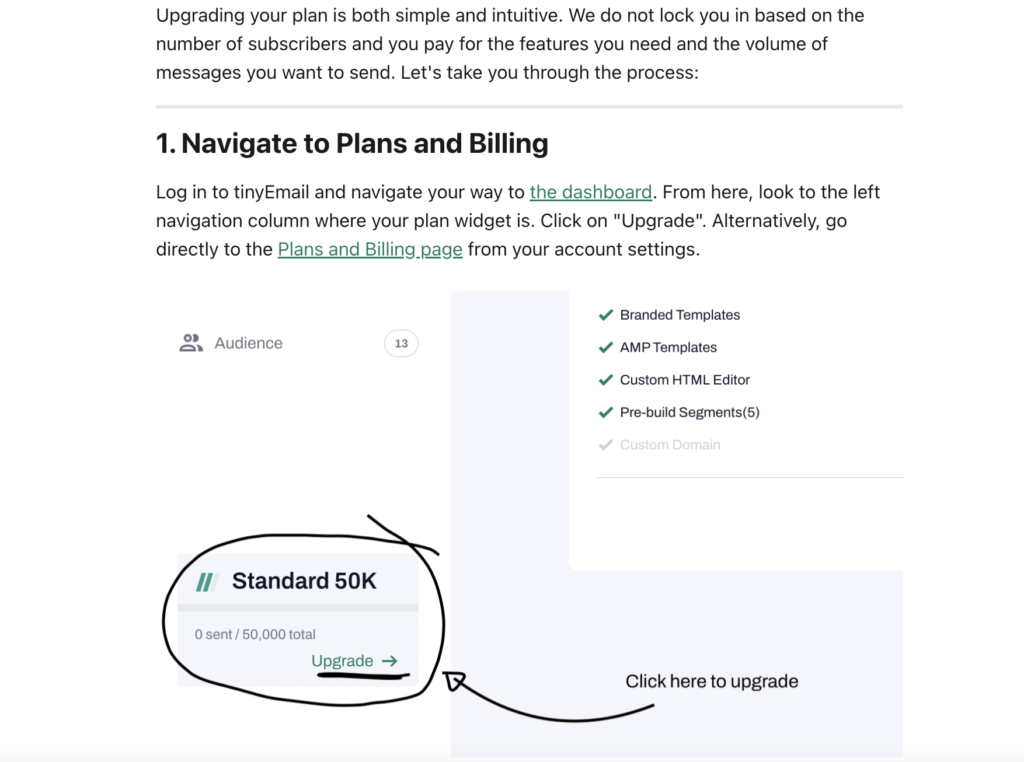
Comparison
When evaluating scalability between TinyEmail vs GetResponse, it becomes evident that both platforms prioritize growth. While GetResponse brings its legacy and proven track record, TinyEmail’s modern architecture and adaptability offer a fresh perspective on scalability. Brands should consider their projected growth, future feature requirements, and budget when choosing between these platforms.
Ultimately, the right choice would be the one that aligns best with a company’s vision for growth and its future email marketing aspirations.
Mobile Optimization
In an era where smartphones have become a primary device for communication and browsing, ensuring email campaigns are mobile-optimized is crucial. The readability, accessibility, and interactivity of email content on mobile devices can significantly impact subscriber engagement.
GetResponse
Understanding the pivotal role of mobile optimization, GetResponse offers responsive email templates that automatically adjust to various screen sizes. Their intuitive drag-and-drop editor lets users preview how emails will appear on mobile devices, ensuring that content remains visually appealing and user-friendly. Moreover, GetResponse provides tools for A/B testing mobile versions, allowing businesses to refine their campaigns for optimal mobile performance.

TinyEmail
TinyEmail also champions mobile optimization. Their design philosophy centers around “mobile-first”, ensuring that emails look pristine on smartphones and tablets. Beyond just templates, TinyEmail’s analytical tools give insights into mobile engagement metrics, helping brands understand their mobile audience’s behavior better. This data-driven approach ensures that businesses can make informed decisions about their mobile email marketing strategies.

Comparison
When it comes to mobile optimization in the GetResponse vs TinyEmail debate, both platforms showcase a clear commitment to ensuring email campaigns shine on mobile devices. GetResponse’s experience and comprehensive tools offer a proven solution, while TinyEmail’s mobile-first design philosophy and in-depth mobile analytics offer a fresh, modern approach.
Brands should consider their target audience’s mobile usage patterns and their own comfort with analytics when choosing between these platforms. Ensuring mobile-friendly campaigns will only become more crucial as mobile browsing continues to dominate the digital landscape.
Key Differentiators: GetResponse vs TinyEmail
The digital marketing arena is replete with tools and platforms, each promising a unique set of features and benefits. But when weighing GetResponse vs TinyEmail, some distinct differentiators come into the limelight.
- Historical Reputation vs Modern Approach: GetResponse has a long-standing reputation in the email marketing domain, having catered to millions of businesses over the years. This history brings with it a tried and trusted platform. TinyEmail, on the other hand, represents a more modern approach, with features and tools more aligned with today’s dynamic marketing needs.
- Depth vs Breadth: While GetResponse offers depth in its features, especially when it comes to automation and analytics, TinyEmail is more about breadth. With a vast array of integrations and a holistic view of marketing, TinyEmail positions itself as a more all-encompassing solution.
- User Experience: Both platforms prioritize user experience, but they approach it differently. GetResponse has refined its platform over years, making it intuitive for both beginners and experts. TinyEmail, with its newer interface, offers a fresh, minimalistic design perspective that resonates with the current design trends.
- Pricing Models: GetResponse offers varied plans, each tailored to different business sizes and needs. TinyEmail’s transparent, scalable pricing ensures that businesses only pay for what they need, making it an attractive option for startups and SMEs.
- Mobile Optimization: In the mobile-centric world, both GetResponse and TinyEmail shine. Yet, while GetResponse provides time-tested responsive templates, TinyEmail’s mobile-first approach and detailed mobile analytics make it a formidable contender in this domain.
- Community and Support: GetResponse, given its tenure in the industry, has built a vast community where users can exchange ideas and best practices. TinyEmail, although newer, prides itself on agile customer support and a rapidly growing user base that champions its features.
In essence, choosing between GetResponse and TinyEmail boils down to specific business needs and preferences. Both platforms excel in their right, offering a blend of traditional and modern email marketing tools. Brands should consider their marketing goals, target audience, and the importance of scalability when making a decision. Whatever your choice, rest assured that both platforms will provide the tools and support needed to drive successful email campaigns.
Further Reading on Email Marketing Solutions
If you found this comparison of GetResponse vs TinyEmail insightful, you might also be interested in some of our other detailed comparisons and reviews:
- Drip vs TinyEmail: Dive deeper into how TinyEmail stacks up against Drip in terms of features, user experience, and more. Read the full comparison here.
- Constant Contact vs TinyEmail: Understand the strengths and weaknesses of both these platforms and see which one aligns more with your business needs. Check out the detailed analysis.
- ActiveCampaign vs TinyEmail: Another comprehensive face-off between two giants in the email marketing world. Discover the ins and outs of both platforms. Get the insights here.
Continue your exploration and ensure you’re making the most informed decision for your email marketing endeavors!


